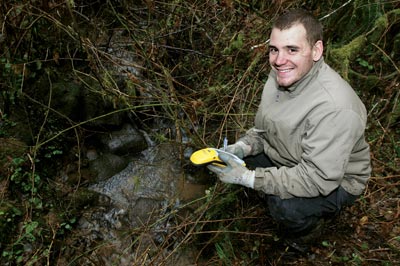Tribal Government & News
German intern learns forestry in Tribal department

Julian Filipp, the second exchange student for the Tribe from the University of Applied Forest Sciences in Rottenburg, Germany, is getting rave reviews from the Natural Resources Department.
"Julian's been a major help for us," said Senior Forester Jason Bernards. "He's gotten us ahead on our stream mapping by a couple months, and that's something we have to do before any timber sale or project, so we can apply our stream buffers."
The University of Applied Forest Sciences is also the alma mater of the Tribe's GIS (geographic information system) coordinator, Volker Mell, host to each of two students from the school who have worked an internship in Grand Ronde.
"He's not getting paid for any of this work," said Bernards, "but he works like he's getting top dollar."
Of three possible graduate paths in the field of forestry - classical forestry, the business of forestry or GIS - Filipp will return to Rottenburg to focus on GIS studies, the field work that he has performed in Grand Ronde for the last six months.
Specifically, he has been mapping the streams, rivers and creeks on the Reservation, categorizing them as either with fish, perennial or intermittent.
"There are several things I look at," said Filipp, "including the vegetation on the banks." If salmonberry is growing, he knows he's got an intermittent stream because salmonberry doesn't grow in water. He knows he has a defined channel if the water seeks its own way.
"I have a GPS (global positioning system) unit," he said. "I take GPS points and then I mark them at the point where they turn from intermittent to perennial.
"The main reason why we do this is when foresters cut an area, perennial streams need a buffer (of remaining trees and vegetation). The main reason is to protect the biology of the area."
Along with saving the Natural Resources Department "a few months worth" of work by noting GPS points on the Reservation, Filipp also helped develop a grid system for the Tribal Cemetery.
"He mapped all the graves with the names for Tribal members visiting the cemetery to help them find relatives there," said Mell. The Tribe now has a grid map with the locations of all the graves.
In addition, many unmarked gravesites have been located, some with ground penetrating radar employed by the Cultural Resources Department, said Mell.
The next step, Mell said, is to post a map of the unmarked graves at the Elders' Activity Center to see if anyone can identify the unmarked sites.
"Julian marked close to 1,000 points," said Mell.
Filipp also worked with longtime Cultural Resources Department contractor Dr. Henry Zenk to redraw a language map of the area.
"Julian's name will be listed among contributors on the map when it is completed," said Mell.
"It was a very great experience," said 24-year-old Filipp, who will return to Germany at the end of February. "I found the work very interesting, (and worked on) very different things. I worked with LIDAR (Light Detection and Ranging) images," optical remote sensing technology that the Tribe uses to map the ground and tree canopy elevation changes of Reservation lands. In addition, it helps give exact locations of the rivers and streams.
"I was out with foresters a couple times," he said, "so I can see how they log here; and with (Tribal) biologists. One day, I was out at the weir to help measure salmon. I got to know the forest trees here and the biology. It's very interesting to see how things work on the Reservation, how they manage the community; how they work with the BIA (Bureau of Indian Affairs)."
"He's incredibly intelligent," said Bernards. "You work with him for a couple hours and you realize he's really intelligent and has a really good work ethic."
In addition, though Filipp worked some weekends to meet deadlines, he also got around to experience Oregon and beyond.
"I've been to a powwow (The Gathering of Oregon's First Nations) last Saturday in Salem, to get to know more about the Natives, to see the ocean, the nature here, and the landscape in general was very interesting," he said. "I've been to Mt. Hood, to California on the coast in the redwoods area, and to Portland a couple of times.
"It was all new to me. We have forests in Europe, but here the trees are bigger, higher. I was impressed with the area here, the landscape."
Mell remembers taking Filipp to visit relatives, where Filipp found two soccer channels on television and actually found his favorite team playing. He was glued to the set, Mell said, until he realized that they were broadcasting a game that had already been played.
"My team is going to lose," Filipp predicted sadly.
Filipp is from Űberlingen, Germany, in the very south of the country, close to the border with Switzerland. It has the biggest lake in Germany, Lake Constance, he said, making it a major tourist region.
